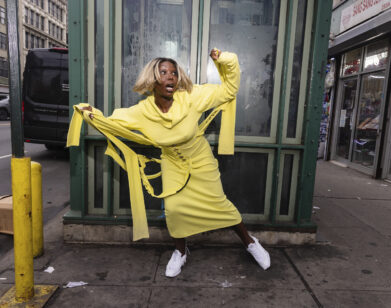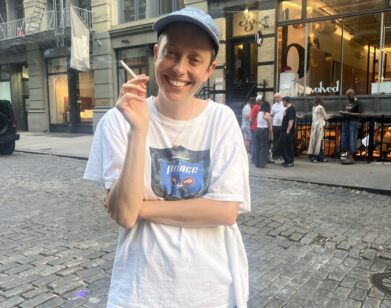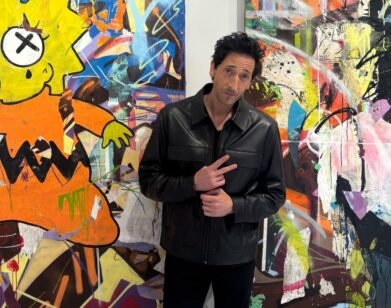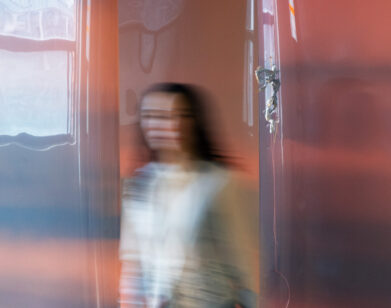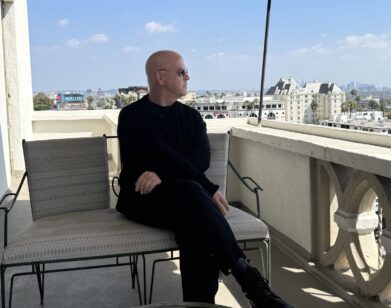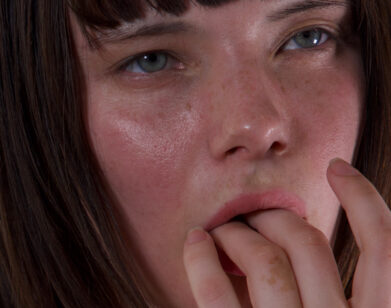Karl Holmqvist’s Way with Words
From Debbie Harry and Beyoncé to Allen Ginsberg and Luc Boltanski references, multi-disciplinary artist Karl Holmqvist deconstructs, reconstructs, and questions the use of language. Within installations, the Swedish-born, Berlin-based artist has employed silver mylar as wallpaper, immediately evoking notions of Warhol’s Factory, while hastily written black words incite questions: Where is this quote from? Do I, or do I not, recognize it? Holmqvist oftentimes juxtaposes quotes taken from pop culture with others that are more genre-specific and narrowly defined. In his current solo show “Tuff Love” at The Power Station in Dallas, Texas, visitors are greeted by Rihanna’s lyrics “Let me cover your shit in glitter,” but upon moving to the gallery’s second floor, visitors read artist Seth Price’s “Most artists didn’t know or understand their own motivations, even avoiding self-scrutiny for fear of scaring off inspiration.” Some quotes, though rarely, are even Holmqvist’s own.
In addition to words scrawled across the 52-year-old’s silver-coated walls at The Power Station, two towering, industrial, cube-like sculptures form the words “tuff” and “love,” each letter comprising one side of the square. The installation process of each sculpture—one is inside, the other outside—was filmed from start to finish, resulting in a video that is also screening upstairs. During the inception and realization of the show, Holmqvist spent one day producing drawings that blur the line between calligraphy and graffiti, which were then compiled, sans editing, into a limited-edition artist’s book.
Previously, Holmqvist’s work has been shown in solo exhibitions around the world, including the Institute of Contemporary Arts in London and Gavin Brown’s Enterprise in New York, as well as in group exhibitions like “Ecstatic Alphabets/Heaps of Language” at New York’s Museum of Modern Art. In 2003 and 2011, he also participated in the Venice Biennale. A few hours before Holmqvist performed a cover of Throbbing Gristle’s “Discipline” during the opening night of “Tuff Love,” we spoke with the artist about popular culture, gender fluidity, and his process.
EMILY MCDERMOTT: I was going to ask you how you felt about Rihanna because you’ve quoted Beyoncé in much of your previous work, but I walked into this show and the first quote I saw was Rihanna’s.
KARL HOLMQVIST: [laughs] I love them both. You can have time for everyone, no? Beyoncé’s the lady and Rihanna’s the tough girl. The people quoted often show up because they spin in your head. You hear things and then you don’t get them out. They select you, basically. Sometimes it’s also people I don’t like; it’s not a fan thing. It’s randomly using phrases, and for people to recognize them is exciting to me. Maybe people know my spiel already, so they know it’s going to be from somewhere, but there’s also a quote from Seth Price, which will be art world familiar, but not to most people. There’s always a selection of things that seem to be surrounding me at the moment. It’s intuitive and improvised and i’s almost all quotes. Lately I started to use my own things a little bit more, but there’s no system, no rules.
MCDERMOTT: Do you think there’s a reason that you’re using your own quotes more?
HOLMQVIST: Maybe because I have more confidence. [laughs] But I always liked the idea of cover versions of things. I was really into Grace Jones, for instance, when I was a kid. I loved her doing Iggy Pop and songs of other people. When I first started to write, I didn’t have anything in my head so I started to use other people’s words just to be able to do something. That’s how it started. There’s Rihanna, Grace Jones, Beyoncé, a lot of ladies that I’m channeling, so I’m also thinking of myself as a drag performer, using all these ladies’ words. Song lyrics, in general, are thought of as minor; all these people are really inventive with language, but people still just think of them as entertainers and not as important writers. Of course, they’re mega famous but in terms of cultural hierarchies, as an artist, you’re much more important in a sense. If I repeat these words, they have a different weight and people pay different attention to them.
MCDERMOTT: But a lot of these pop icons have other people write their songs…
HOLMQVIST: That’s another issue. At least it’s out there and they’re circulating these words. It’s inspiring.
MCDERMOTT: Saying that you consider yourself a drag performer reminded me of another article, where you said that you considered yourself a feminist and that “women are men and men are women.”
HOLMQVIST: I like people being gender fluid. I think it’s very important that gay men fight for women and women fight for other cultures and races, so that we’re all helping each other. That’s the only way we’re all going to be equal, if that ever happens. I don’t think as a black artist that you should only talk about being black, or as a gay artist you should only talk about being gay, especially as artists, where you have the freedom to imagine yourself in any which way. It’s important to test these other voices. Also in terms of feminism, or women on the planet, I think there’s a huge imbalance. It’s important for everyone’s sake that women have more room and more of a say in how things are processed. I think that would help the planet, it would help all of us. That said, though, this exhibition is super macho. It’s called “Tuff Love.” It’s kind of a guy thing. [laughs] But it’s so macho that it’s almost like a parody, like the Village People, kind of over the top. We have the tinsel curtains and some glitter so it’s a mix, but it’s quite a macho show.
MCDERMOTT: And why did you spell tough T-U-F-F?
HOLMQVIST: There’s two sculptures, “tuff” and “love,” and the sculptures are always four letters because there’s four sides, so you couldn’t spell “tough” the way you’re supposed to. But I decided to spell love L-O-V-E; I made one before that’s L-U-V-V and there are other sculptures with fluorescent tube lights, where I made one say “lurve.” I enjoy playing around with right and wrong, and breaking the rules for how you’re supposed to interact with language.
MCDERMOTT: This is only the second video you’ve made of a sculpture being built. For you, what is the significance of the video?
HOLMQVIST: I started making the sculptures about a year ago. I was looking at putting them up and it was so intense—they had a forklift and trucks in the gallery—and I was like, “Wow, I should have filmed this,” but I didn’t have the chance. Then I did it at the art fair in Berlin and again here. The sculptures are there and the films are there, so you realize, “This must have been made in the last two days, while they were putting this thing up.” I like the immediacy of that. It’s a little bit like the writing on the wall; there’s a connection to temporality and performance. Somehow there’s structure, but it’s a lot of improvisation. I hope that it will give people some sense of freedom, that it’s together but at the same time just thrown together.
MCDERMOTT: With that, it’s interesting to turn to the artist’s book because it was all made in one sitting without any editing.
HOLMQVIST: I’m very happy with the book and again, it’s a different temporality than what books usually take. There’s a different way of handling language or handling this task of writing. It’s also based on Alarme, this book of calligraphic writing from Brion Gysin that he finished in the ’70s. It was reprinted recently and has the same format as my book. If you see it in the gallery you think of tagging or vandalism, but I find it interesting to connect it to the tradition of calligraphy in Arab culture. You’re not allowed to use the image so it’s always about the writing, that’s their art, to make these beautiful signs. Also, these monks often make the work in 30 seconds, but they’ve been practicing for years to have that hand and the freedom to do it. This is all very interesting to me.
MCDERMOTT: I also want to talk about the performance and why you chose to cover “Discipline.” The imagery for that single is highly charged. On one side, the band is standing in front of the ex-Nazi Ministry of Propaganda in Berlin and the other side has Val [Denham] holding a Hitler Youth dagger…
HOLMQVIST: Right… [laughs] I didn’t remember that, and that’s not exactly my politics, or theirs, I don’t think. It’s just provocation. It’s a great song, I’m doing it with Stefan Tcherepnin, a great composer and noise musician, and we have a version of it that is really tight and good. I also I thought it was nice to have this industrial music performance in this space, together with all the other elements.
I saw Throbbing Gristle perform in Berlin on New Year’s Eve in 2006, when they reunited for a couple of months. I don’t know if it’s meant to mean anything specific; I think it’s just an empowering sentence. It’s not saying that there is discipline. It’s saying that someone wants discipline. The song never says specifically whether it is actually there or not. Other than that, I do like things to be ordered.
“TUFF LOVE” WILL BE ON VIEW AT THE POWER STATION IN DALLAS UNTIL JUNE 17, 2016.


